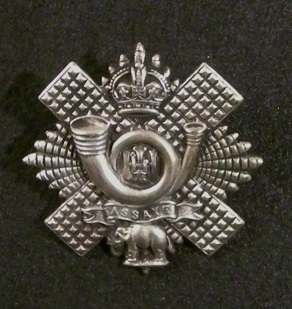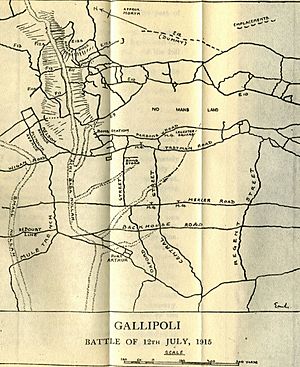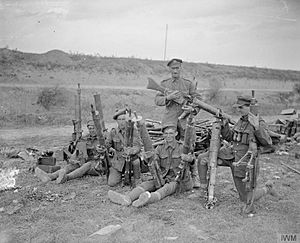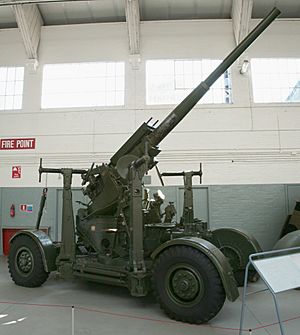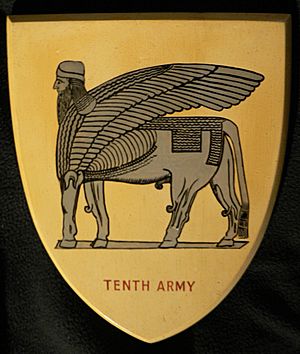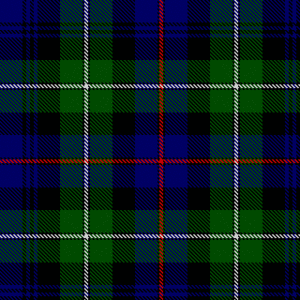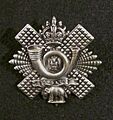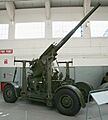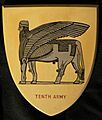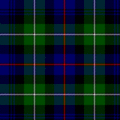Blythswood Rifles facts for kids
Quick facts for kids Blythswood Rifles7th (Blythswood) Battalion, Highland Light Infantry 83rd (Blythswood) Heavy Anti-Aircraft Regiment, Royal Artillery 483rd (Blythswood) Heavy Anti-Aircraft Regiment, Royal Artillery |
|
|---|---|
| Active | 24 September 1859 – 10 March 1955 |
| Country | |
| Branch | |
| Role | Infantry Air Defence |
| Part of | 52nd (Lowland) Division 65th (2nd Lowland) Division 3 Anti-Aircraft Division 12 Anti-Aircraft Division Tenth Army |
| Garrison/HQ | Glasgow |
| Engagements | Second Boer War Gallipoli Campaign Sinai and Palestine Campaign Western Front The Blitz |
| Commanders | |
| Notable commanders |
Col Archibald Campbell, 1st Baron Blythswood |
The Blythswood Rifles was a special group of volunteer soldiers from Scotland. They were part of the British Army. This unit started in Glasgow in 1859. Later, it became a battalion within the famous Highland Light Infantry regiment.
During World War I, the Blythswood Rifles fought in several important places. These included Gallipoli, Egypt and Palestine, and on the Western Front. Just before World War II, they changed their role. They became an anti-aircraft artillery regiment. This meant they helped defend against enemy planes. They served during The Blitz in Britain and in the Middle East. The unit continued to serve in the Territorial Army until 1955.
Contents
- How the Blythswood Rifles Started
- Becoming Part of the Highland Light Infantry
- Joining the Territorial Force
- The Blythswood Rifles in World War I
- Between the World Wars
- The Blythswood Rifles in World War II
- After the War
- Uniforms and Badges
- Important Leaders
- Memorials
- Images for kids
- External Sources
How the Blythswood Rifles Started
In 1859, people in Britain worried about a possible invasion. This led to many volunteer groups forming across the country. These groups were made of part-time soldiers. They wanted to help the regular British Army if needed.
One such group was the 2nd Administrative Battalion of Lanarkshire Rifle Volunteer Corps. It formed in Glasgow in 1860. This battalion brought together many smaller volunteer companies. These companies were made up of people from different jobs. For example, there were groups of grocers, tailors, and leather workers.
In 1865, these smaller groups officially became the 31st Lanarkshire Rifle Volunteer Corps. Their main office was in Glasgow. In 1869, they got a special new name: The Blythswood Rifles. This name honored their leader, Archibald Campbell. He was a brave soldier who had fought in the Crimean War. In 1873, the Blythswood Rifles grew even larger. They joined with another group, the 5th Lanarkshire RVC, which also had many volunteers from Glasgow.
Becoming Part of the Highland Light Infantry
In 1880, the Blythswood Rifles were renumbered as the 8th (Blythswood Rifles) Lanarkshire RVC. A year later, in 1881, they became a volunteer battalion of the famous Highland Light Infantry (HLI). This was a big change, linking them to a well-known Scottish regiment. In 1887, they were officially called the 3rd (Blythswood) Volunteer Battalion, Highland Light Infantry.
By 1888, a new plan helped volunteer units train better. They would gather in special brigades for practice. The HLI battalions, including the Blythswood Rifles, formed the Highland Light Infantry Brigade.
The Blythswood Rifles sent 61 volunteers to fight in the Second Boer War (1899-1902). They fought alongside regular soldiers. This earned the battalion its first special honor: South Africa 1900–02. In 1902, the battalion built a new training hall in Glasgow. They also had a shooting range nearby for target practice.
Joining the Territorial Force
In 1908, a new army group called the Territorial Force (TF) was created. The Blythswood Rifles became the 7th (Blythswood) Battalion, Highland Light Infantry. Their brigade, the HLI Brigade, was now part of the Lowland Division of the TF.
The Blythswood Rifles in World War I
Getting Ready for War
When World War I began on August 4, 1914, the Lowland Division was at its yearly training camp. They quickly got ready for war. The 7th HLI, led by Lieutenant-Colonel J.H. Galbraith, helped guard important places around Glasgow. They trained hard through the winter of 1914–15.
Many soldiers volunteered to serve overseas. To keep up with the demand, new "2nd Line" and "3rd Line" units were created. These new units trained soldiers to replace those sent to fight.
1/7th Highland Light Infantry Overseas
The 1/7th HLI, the main battalion, was sent overseas in May 1915. They sailed to Egypt first. Then, they were sent to the Gallipoli Campaign in Turkey.
Fighting at Gallipoli
The 1/7th HLI landed at Cape Helles on July 3, 1915. They quickly moved to the front lines. On July 12, they took part in a big attack at Achi Baba Nullah. The battalion bravely advanced under heavy enemy fire. They captured the Turkish trenches but faced many challenges. They suffered many casualties, with soldiers killed, wounded, or missing.
For the next three months, the 1/7th HLI fought in the front lines. They faced constant shelling and Turkish attacks. Many soldiers also became sick due to the harsh conditions. By December, it was decided to leave Gallipoli. The 1/7th HLI helped with the final evacuation. They used clever tricks to make the enemy think the lines were still strongly held. The battalion left Gallipoli on January 9, 1916. They had lost many soldiers during this difficult campaign.
Service in Egypt and Palestine
After Gallipoli, the 52nd (Lowland) Division moved to Egypt. They helped defend the Suez Canal. In August 1916, they fought off a German and Turkish attack in the Battle of Romani. The British artillery and other forces successfully pushed back the enemy.
In late 1916, the British forces moved to invade Palestine. The 52nd (Lowland) Division was involved in the Sinai and Palestine Campaign. In April 1917, the 1/7th HLI played a key role in the 2nd Battle of Gaza. They bravely captured important hills, pushing back the Turkish forces. They continued to fight in difficult conditions, often under heavy fire.
In November 1917, the 1/7th HLI helped lead the pursuit of the Turks after the 3rd Battle of Gaza. They secured both sides of the Wadi el Hesi. One company of the 7th HLI advanced "as if it was carrying out a parade movement" under heavy fire. They continued to advance, breaking through Turkish defenses.
The battalion also helped capture Jerusalem in December 1917. They then took part in a daring crossing of the Nahr el Auja. This was a very difficult operation, but the 7th HLI successfully crossed the river and attacked the Turkish trenches from an unexpected direction. This was called "one of the most remarkable feats of the Palestine Campaign."
Moving to the Western Front
In March 1918, the 52nd (Lowland) Division, including the 7th HLI, was sent to the Western Front in France. They arrived in April and began training. They soon moved to the front lines near Vimy.
In August, the division joined the successful Hundred Days Offensive. The 157th Brigade, including the 7th HLI, attacked the Hindenburg Line. They faced strong opposition and heavy casualties but pushed forward. The fighting was intense, especially in a maze of trenches.
In September, the 7th HLI was involved in bitter fighting at Mœuvres. Their commanding officer, Lieutenant-Colonel Gibbons, was sadly wounded during this battle. The battalion then took part in the Battle of the Canal du Nord, helping to clear the canal and the Hindenburg Line.
By October, the German defenses were collapsing. On November 7, the 7th HLI crossed the Jard Canal. On November 10, they attacked Herchies. When the Armistice with Germany (the end of the war) came into effect at 11:00 AM on November 11, 1918, the division was still fighting.
After the war, the soldiers were sent home. The 7th HLI was officially disbanded on May 24, 1919.
2/7th Highland Light Infantry (Home Service)
A "2nd Line" battalion, the 2/7th HLI, was formed in September 1914. This unit trained soldiers and supplied replacements for the main battalion fighting overseas. In January 1917, the 2/7th HLI moved to Ireland to help keep peace there. By July 1917, this battalion was replaced by other training units and was officially disbanded in January 1918.
Between the World Wars
The Territorial Army was reformed in 1920. The 7th HLI was again part of the 157th (HLI) Brigade. In the 1930s, Britain needed better defenses against air attacks. So, many infantry battalions, including the 7th HLI, were changed into anti-aircraft (AA) units.
On November 1, 1938, the 7th HLI became the 83rd (7th (Blythswood) Battalion, Highland Light Infantry) Anti-Aircraft Regiment, Royal Artillery. They were based in Glasgow. In July 1939, they shortened their name to 83rd (Blythswood) AA Regiment. They were part of the 42nd Anti-Aircraft Brigade, which protected Glasgow and the River Clyde.
The Blythswood Rifles in World War II
Getting Ready for War
In February 1939, a new command was set up for air defenses. It was called Anti-Aircraft Command. In August, just before World War II officially began, all AA units were fully ready at their defense positions.
By June 1940, the 83rd Regiment was called a Heavy Anti-Aircraft (HAA) unit. This was to show they used larger guns to shoot down planes.
Defending Against The Blitz
The 83rd (Blythswood) HAA Regiment continued to defend Glasgow. After the Battle of Britain, the German air force (Luftwaffe) began bombing British cities at night. This period was known as 'The Blitz'. Glasgow and nearby Clydebank were heavily bombed in March 1941. The 83rd HAA Regiment worked hard to defend the area.
The regiment also helped train new soldiers for other HAA units. By July 1941, the 83rd (Blythswood) HAA Regiment was sent overseas to help in other war zones.
Serving in the Middle East
By October 1941, the regiment was in the Middle East. They were sent to Iraq to help defend important oil fields. They were the only HAA unit in the Tenth Army for a while. Their job was to protect places like Basra, Baghdad, and the oil facilities at Kirkuk. Each of these areas received one HAA battery (a group of guns).
The 83rd (Blythswood) HAA Regiment also had important training roles. They helped train four Polish AA regiments. They also provided experienced soldiers to help form a new Indian HAA regiment. By 1943, the German air force was no longer a threat in the Middle East. So, the AA defenses were reduced. The 83rd HAA Regiment moved to Palestine. The regiment was officially put on hold in North Africa in September 1944.
After the War
When the Territorial Army was re-established in January 1947, the regiment reformed in Glasgow. It was called the 483rd (Blythswood) (Mixed) Heavy Anti-Aircraft Regiment, RA. The word 'Mixed' meant that women from the Women's Royal Army Corps were now part of the unit.
On March 10, 1955, the AA Command was disbanded. Many AA units in the Territorial Army were combined. The 483rd (Blythswood) HAA Regiment joined with other regiments to form a new unit. This new unit was called the 445 (Cameronians) LAA Regiment. The Blythswood name continued in one of its batteries. However, after further changes in 1961 and 1967, the Blythswood name was no longer used.
Uniforms and Badges
When the volunteer groups first started in 1859–60, they wore different uniforms. But by 1861, the 2nd Admin Battalion wore dark green uniforms with red collars. Later, they changed to scarlet (bright red) jackets with blue details. From 1886, the battalion adopted the full uniform of the Highland Light Infantry. This included yellow facings and tartan Trews (trousers). The tartan would have been the Mackenzie No 5 tartan, which was the HLI's special pattern.
From 1947 to 1955, the 483rd HAA Regiment wore a Mackenzie tartan patch on their uniform sleeves.
Important Leaders
The following people served as honorary (special) colonels of the battalion:
- Alex. C. Ewing, from 1864 to 1902.
- Col Lord Blythswood, who was their former commanding officer, appointed in 1902.
- Col W. Clarke, who was also a former commanding officer, from 1908.
- Squadron-Leader Douglas Douglas-Hamilton, Marquess of Douglas and Clydesdale (later the Duke of Hamilton), appointed in 1931.
Memorials
There is a stone monument in Glasgow Green that remembers the 7th (Blythswood) Battalion HLI soldiers who died in World War I. It is near their old headquarters. There is also a memorial for all HLI soldiers who died in World War I inside Glasgow Cathedral.
Images for kids
External Sources
- Mark Conrad, The British Army, 1914 (archive site)
- IWM War Memorials Register.
- The Long, Long Trail
- Orders of Battle at Patriot Files
- Land Forces of Britain, the Empire and Commonwealth – Regiments.org (archive site)
- The Regimental Warpath 1914–1918 (archive site)
- Royal Artillery 1939–1945
- Scottish Military History
- Scottish Military Research Group – Commemorations Project.
- Graham Watson, The Territorial Army 1947
- British Army units from 1945 on


